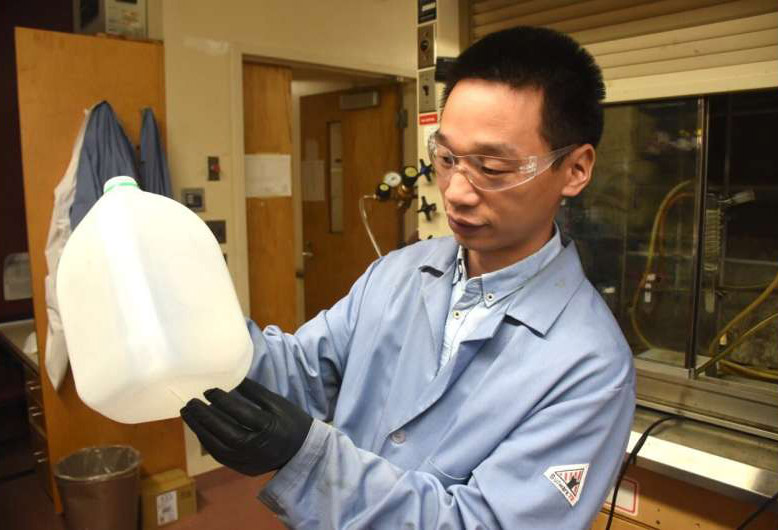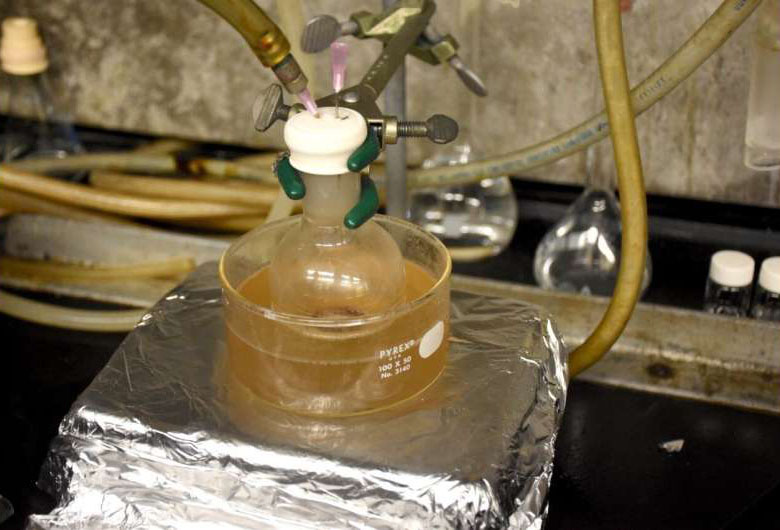New Recycling Technology Creates Plastics Soap

Virginia Tech researchers develop process to convert polyolefin waste into soap precursor
Plastics is in a recycling renaissance. Many technologies, new and old, are being considered to convert waste into valuable, sustainable materials. The latest technology is a technique for converting polyolefins into short-chain molecular waxes which, after a few steps, can be upcycled into soap.
Researchers developed this process at Virginia Tech University (https://vt.edu). The lead researcher was Dr. Guoliang Liu, associate professor of chemistry in the College of Science. He was assisted by two PhD chemistry candidates, Zhen Xu and Eric Munyaneza.
Dr. Liu knew that the chemical structure of polyethylene is similar to fatty acid, a precursor of soap. PE and fatty acids have long carbon chains, though fatty acids have an extra group of atoms at the end of their chain.
Converting Long Polyolefin Chains to Short-Chain Waxes

A flask filled with waxes from waste PE and PP is heated in an oil bath and oxidized by airflow to produce fatty waxes via catalytic oxidation.
Liu saw that this similarity implied that it should be possible to convert PE—specifically, post-consumer HDPE and LDPE, as well as polypropylene and commingled PE/PP—into waxes by heating them and eventually producing soap.
The challenge was breaking the long polyolefin chain into short chains. This would create an upcycling method that could take low-value polyolefin waste and convert it into a high-value soap precursor.
Liu believed that the resulting waxes could be oxidized over manganese catalysts to produce valuable surfactants. He calls this process temperature-gradient thermolysis.
To do this, Liu obtained a custom quartz reactor—a cylindrical container jacketed by a water condenser and equipped with two inlets and a round quartz cap. The reactor volume was ~ 0.3 L (10.14 U.S. fluid ounces) and the bottom surface area was ⁓ 70 sq. cm. (about 10.9 square inches). The team collected 1 kg. (2.2 pounds) of post-consumer polyolefin waste from public disposal sites. Contaminants were not removed. The material was pulverized and manually mixed then transferred to the reactor. The contents comprised 25 percent each of HDPE, LDPE, PP and unsorted PE/PP.
(A description of the process is in the paper Liu and team published Aug. 10 in Science: “Chemical upcycling of polyethylene, polypropylene and mixtures to high-value surfactants.”)
The bottom of the reactor was heated in stages to 300°C (572°F), enough to break the polymer chains of the polyolefins, and at the top cooled enough to stop further breakdown. After thermolysis, the researchers gathered the residue and found it was composed of short-chain polyolefins, or waxes.
According to the paper, the average wax component to emerge from thermolysis was 87 percent for HDPE, 91 percent for LDPE, 76 percent for PP and 74 percent for the PE/PP mix.
Refine the Waxes, Get Polyolefin Soap
After adding a few steps, including saponification, the team made the world’s first soap out of plastics.
“Our research demonstrates a new route for plastic upcycling without novel catalysts or complex procedures,” said Zhen Xu, lead author of the paper. “This will enlighten people to develop more creative … upcycling procedures in the future.”
One feature of the process is it can be used on PE and PP at the same time—it’s not necessary to separate the two. This is a major advantage over some recycling methods, which require careful sorting of plastics to avoid contamination.
Another benefit is simple requirements: plastic and heat. Although later steps in the process require additional ingredients to convert wax molecules into fatty acids and soap, the initial transformation of plastic is a straightforward reaction. This reportedly contributes to its cost-effectiveness and low environmental impact.
For upcycling to be effective on a large scale, the final product must be valuable enough to cover process costs and make it more economically attractive than other recycling options. Liu’s calculations suggest that the process can be scaled up and used profitably in commercial production.
We’ll look at the economics of commercial production in a coming post.
